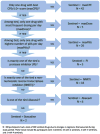Relationships among neurocognitive status, medication adherence measured by pharmacy refill records, and virologic suppression in HIV-infected persons
- PMID: 23202813
- PMCID: PMC3906725
- DOI: 10.1097/QAI.0b013e31827ed678
Relationships among neurocognitive status, medication adherence measured by pharmacy refill records, and virologic suppression in HIV-infected persons
Abstract
Background: Optimal antiretroviral therapy (ART) effectiveness depends on medication adherence, which is a complex behavior with many contributing factors, including neurocognitive function. Pharmacy refill records offer a promising and practical tool to assess adherence.
Methods: A substudy of the CHARTER (CNS HIV Anti-Retroviral Therapy Effects Research) study was conducted at the Johns Hopkins University (JHU) and the University of Washington. Pharmacy refill records were the primary method to measure ART adherence, indexed to a "sentinel" drug with the highest central nervous system penetration-effectiveness score. Standardized neuromedical, neuropsychological, psychiatric, and substance use assessments were performed at enrollment and at 6 months. Regression models were used to determine factors associated with adherence and relationships between adherence and changes in plasma and cerebrospinal fluid HIV RNA concentrations between visits.
Results: Among 80 (33 at JHU and 47 at University of Washington) participants, the mean adherence score was 86.4%, with no difference between sites. In the final multivariable model, better neurocognitive function was associated with better adherence, especially among participants who were at JHU, male, and HIV infected for a longer period of time. Worse performance in working memory tests was associated with worse adherence. Better adherence predicted greater decreases in cerebrospinal fluid HIV RNA between visits.
Conclusions: Poorer global neurocognitive functioning and deficits in working memory were associated with lower adherence defined by a pharmacy refill record measure, suggesting that assessments of cognitive function, and working memory in particular, may identify patients at risk for poor ART adherence who would benefit from adherence support.
Conflict of interest statement
For the remaining authors, no potential conflicts of interest were reported.
Figures
References
-
- Hammer SM, Squires KE, Hughes MD, et al. A controlled trial of low nucleoside analogues plus indinavir in persons with human immunodeficiency virus infection and CD4 cell counts of 200 per cubic millimeter or less. AIDS Clinical Trials Group 320 Study Team. N Engl J Med. 1997;337:725–33. - PubMed
-
- Sacktor N, Lyles RH, Skolasky R, et al. HIV-associated neurologic disease incidence changes: Multicenter AIDS Cohort Study, 1990–1998. Neurology. 2001;56:257–60. - PubMed
-
- Bartlett JA. Addressing the challenges of adherence. J Acquir Immune Defic Syndr. 2002;29 (Suppl 1):2–10. - PubMed
-
- Chesney MA. The elusive gold standard. Future perspectives for HIV adherence assessment and intervention. J Acquir Immune Defic Syndr. 2006;43(Suppl 1):149–55. - PubMed
Publication types
MeSH terms
Substances
Grants and funding
LinkOut - more resources
Full Text Sources
Other Literature Sources
Medical


